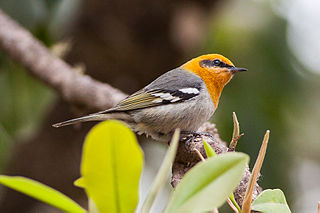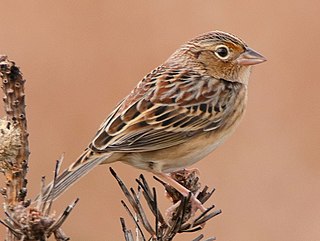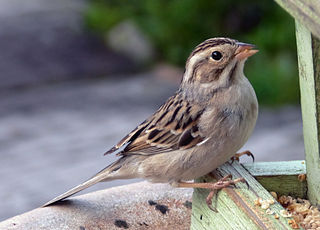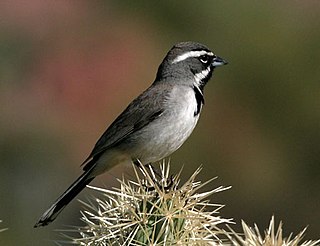
The olive warbler is a small passerine bird. It is the only member of the genus Peucedramus and the family Peucedramidae.

The white-crowned sparrow is a species of passerine bird native to North America. A medium-sized member of the New World sparrow family, this species is marked by a grey face and black and white streaking on the upper head. It breeds in brushy areas in the taiga and tundra of the northernmost parts of the continent and in the Rocky Mountains and Pacific coast. While southerly populations in the Rocky Mountains and coast are largely resident, the breeding populations of the northerly part of its range are migratory and can be found as wintering or passage visitors through most of North America south to central Mexico.

The lark sparrow is a fairly large New World sparrow. It is the only member of the genus Chondestes.

The grasshopper sparrow is a small New World sparrow. It belongs to the genus Ammodramus, which contains three species that inhabit grasslands and prairies. Grasshopper sparrows are sometimes found in crop fields and they will readily colonize reclaimed grassland. In the core of their range, grasshopper sparrows are dependent upon large areas of grassland where they avoid trees and shrubs. They seek out heterogenous patches of prairie that contain clumps of dead grass or other vegetation where they conceal their nest, and also contain barer ground where they forage for insects, spiders, and seeds. Grasshopper sparrows are unusual among New World sparrows in that they sing two distinct song types, the prevalence of which varies with the nesting cycle. The primary male song, a high trill preceded by a stereotyped series of short chips, is reminiscent of the sounds of grasshoppers and is the origin of this species' name. Like some other birds of the central North American grasslands, this species also moves around a lot, not only via annual migrations, but individuals frequently disperse between breeding attempts or breeding seasons. Grasshopper sparrows are in steep decline across their range, even in the core of the breeding distribution in the tallgrass prairies of the central Great Plains. The Florida grasshopper sparrow is highly endangered.

The clay-colored sparrow or clay-coloured sparrow is a small New World sparrow of North America.

The flammulated owl is a small migratory North American owl in the family Strigidae. It is the only species placed in the genus Psiloscops.

The blue-throated mountaingem, also known as the blue-throated mountain-gem or blue-throated hummingbird is a species of hummingbird in tribe Lampornithini of subfamily Trochilinae. It is found in the United States and Mexico.

The bronzed cowbird, once known as the red-eyed cowbird, is a small icterid.

The pyrrhuloxia or desert cardinal is a medium-sized North American songbird found in the American southwest and northern Mexico. This distinctive species with a short, stout bill and red crest and wings, and closely resembles the northern cardinal and the vermilion cardinal, which are in the same genus.

The yellow-eyed junco is a species of junco, a group of small New World sparrows.

The black-throated sparrow is a small New World sparrow primarily found in the southwestern United States and Mexico. It is the only member of the genus Amphispiza; the five-striped sparrow, formerly also classified in Amphispiza, is now thought to be in the monotypic genus Amphispizopsis.

The black-chinned sparrow is a small bird in the genus Spizella, in the New World sparrow family Passerellidae. It is found in the southwestern United States and throughout much of Mexico north of the Isthmus of Tehuantepec; most populations in the US migrate south after breeding while those in Mexico are resident. It is a slim, long-tailed bird, primarily gray with a reddish-brown back streaked with black, brown wings and tail, a pink beak, and brownish legs and feet. In the breeding season, the male shows black on his throat, chin, and the front of his face. Females, youngsters and nonbreeding males show little or no black in these areas. An unobtrusive bird, it spends much of its time foraging slowly along the ground, either alone or in small groups, sometimes mixing with other Spizella species. It is an omnivore, feeding primarily on seeds during the winter and insects during the summer. It builds a cup-shaped nest of grasses, rootlets, or plant fibers, into which the female lays 2–5 pale blue eggs. The female does most or all of the egg incubation, but both parents feed the hatched nestlings.

The rufous-crowned sparrow is a small American sparrow. This passerine is primarily found across the Southwestern United States and much of the interior of Mexico, south to the transverse mountain range, and to the Pacific coast to the southwest of the transverse range. Its distribution is patchy, with populations often being isolated from each other. Twelve subspecies are generally recognized, though up to eighteen have been suggested. This bird has a brown back with darker streaks and gray underparts. The crown is rufous, and the face and supercilium are gray with a brown or rufous streak extending from each eye and a thick black malar streak.

Cassin's sparrow is a medium-sized sparrow.

Cassin's vireo is a small North American songbird, ranging from southern British Columbia in Canada through the western coastal states of the United States, including California, Oregon, and Washington. The Cassin’s Vireo moves down Western United States forests in its migration. During its migration in early spring and late fall, it spends the winter in regions from southern Arizona to southern Mexico, including parts of Baja California and the Pacific coast of Mexico.

New World sparrows are a group of mainly New World passerine birds, forming the family Passerellidae. They are seed-eating birds with conical bills, brown or gray in color, and many species have distinctive head patterns.

The purple martin is a passerine bird in the swallow family Hirundinidae. It is the largest swallow in North America. Despite its name, the purple martin is not truly purple. The dark blackish-blue feathers have an iridescent sheen caused by the diffraction of incident light giving them a bright blue to navy blue or deep purple appearance. In some light, they may even appear green in color.

Bell's sparrow is a medium-sized sparrow of the western United States and northwestern Mexico. It used to be placed in the genus Amphispiza, but recent evidence suggested it be placed in its own genus.




















